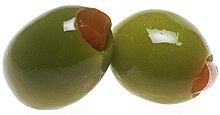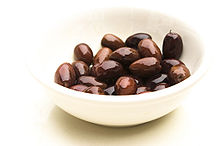Olive (color)
| Olive | |
|---|---|
| Hex triplet | #808000 |
| sRGBB (r, g, b) | (128, 128, 0) |
| HSV (h, s, v) | (60°, 100%, 50%) |
| CIELChuv (L, C, h) | (52, 57, 86°) |
| Source | X11 color names |
| B: Normalized to [0–255] (byte) | |

Olive is a dark yellowish-green color,[1] like that of unripe or green olives.
As a color word in the English language, it appears in late Middle English. Shaded toward gray, it becomes olive drab.
Variations
Olivine

| Olivine | |
|---|---|
| Hex triplet | #9AB973 |
| sRGBB (r, g, b) | (154, 185, 115) |
| HSV (h, s, v) | (87°, 38%, 73%) |
| CIELChuv (L, C, h) | (71, 48, 108°) |
| Source | [1]/Maerz & Paul[2] |
| B: Normalized to [0–255] (byte) | |
Olivine is the typical color of the mineral olivine.
The first recorded use of Olivine as a color name in English was in 1912.[3]
Olive drab
| Olive Drab | |
|---|---|
| Hex triplet | #6B8E23 |
| sRGBB (r, g, b) | (107, 142, 35) |
| HSV (h, s, v) | (80°, 75%, 56%) |
| CIELChuv (L, C, h) | (55, 60, 107°) |
| Source | X11 color names |
| B: Normalized to [0–255] (byte) | |
| Olive drab camouflage | |
|---|---|
| Hex triplet | #544F3D |
| sRGBB (r, g, b) | (84, 79, 61) |
| HSV (h, s, v) | (47°, 27%, 33%) |
| CIELChuv (L, C, h) | (34, 14, 73°) |
| Source | Federal Standard 595 33070 |
| B: Normalized to [0–255] (byte) | |
Olive drab is variously described as a "dull olive-green colour" (Oxford English Dictionary);[4] "a shade of greenish-brown" (Webster's New World Dictionary);[5] "a dark gray-green" (MacMillan English dictionary); "a grayish olive to dark olive brown or olive gray (American Heritage Dictionary);[6] or "A dull but fairly strong gray-green color" (Collins English Dictionary). It was widely used as a camouflage color for uniforms and equipment in the armed forces, particularly by the U.S. Army during the Second World War. (see illustrations below).
The first recorded use of olive drab as a color name in English was in 1892.[7] Drab is an older color name, from the middle of the 16th century. It refers to a dull light brown color, the color of cloth made from undyed homespun wool. It took its name from the old French word for cloth, drap.[4]
Olive drab was the color of the standard fighting uniform for U.S. GIs and military vehicles during World War II. U.S. soldiers often referred to their uniforms as "OD's" due to the color. The color used at the beginning of the war by the U.S. Army was officially called Olive Drab #3, which was replaced by the darker Olive Drab #7 by 1944, and which was again replaced by Olive Green 107 or OG-107 in 1952,[8] and continued as the official uniform color for combat fatigues through the Vietnam War, until replaced by by M81 woodland camo fatigues as the primary U.S. uniform pattern (based on the ERDL pattern used by some soldiers in Vietnam) in the 1981, which retained olive drab as one of the color swatches in the pattern.
As a solid color, it is not as effective for camouflage as multiple-color camo schemes (e.g., U.S. Army Combat Uniform, Tigerstripe, MARPAT, Multicam etc.), though it is still used by the U.S. military to color webbing and accessories. The armies of Israel, India, Cuba, Venezuela, and Austria wear solid color olive drab uniforms.
In the American novel A Separate Peace, Finny says to Gene, "...and in these times of war, we all see olive drab, and we all know it is the patriotic color. All others aren't about the war; they aren't patriotic."
There are many shades and variations of olive drab; one common version is defined by Federal Standard 595 in the United States.[9]
-
An olive drab M-1943 field jacket, worn by U.S. soldiers in World War II.
-
Olive drab is the uniform color today of the Israel Defense Forces.
Olive green
Olive green is greener than olive or olive drab but less green than dark olive green. An example is U.S. Army olive green 107:

Dark olive green
| Dark Olive Green | |
|---|---|
| Hex triplet | #556B2F |
| sRGBB (r, g, b) | (85, 107, 47) |
| HSV (h, s, v) | (82°, 56%, 42%) |
| CIELChuv (L, C, h) | (42, 38, 106°) |
| Source | X11 |
| B: Normalized to [0–255] (byte) | |
Displayed at right is the web color dark olive green.
Black olive

| Olive (RAL) | |
|---|---|
| Hex triplet | #3B3C36 |
| sRGBB (r, g, b) | (59, 60, 54) |
| HSV (h, s, v) | (70°, 10%, 24%) |
| CIELChuv (L, C, h) | (25, 4, 93°) |
| Source | RAL |
| B: Normalized to [0–255] (byte) | |
Black olive is a color in the RAL color matching system. It is designated as RAL 6015.
The color "black olive" is a representation of the color of black olives, the variety of olives sold in cans in supermarkets.
This is one of the colors in the RAL color matching system, a color system widely used in Europe. The RAL color list originated in 1927, and it reached its present form in 1961.
Olive in human culture
- Ethnography
- The term "olive-skinned" is sometimes used to denote shades of medium-toned skin that is darker than the average color for Caucasians, especially in connection with a Mediterranean ethnicity.
See also
References
- ^ "Olive – Definition of olive by Merriam-Webster". merriam-webster.com.
- ^ The color displayed in the color box above matches the color called olivine in the 1930 book by Maerz and Paul A Dictionary of Color New York:1930 McGraw-Hill; the color olivine is displayed on page 59, Plate 18, Color Sample C6.
- ^ Maerz and Paul A Dictionary of Color New York: 1930—McGraw-Hill Page 200; Color Sample of Olivine: Page 59, Plate 18, Color Sample C6
- ^ a b Oxford English Dictionary, 5th Edition, 1982
- ^ Webster's New World Dictionary of the American Language";
- ^ American Heritage Dictionary of the American Language, 4th edition.
- ^ Maerz and Paul A Dictionary of Color New York:1930 McGraw-Hill Page 200; Color Sample of Olive Drab: Page 53 Plate 15 Color Sample J5
- ^ "Soldier'S Barracks Bag". Olive-drab.com. 2008-05-22. Retrieved 2009-04-15.
- ^ "What Does Olive Drab Mean?". Olive-drab.com. 2008-05-22. Retrieved 2009-04-15.


